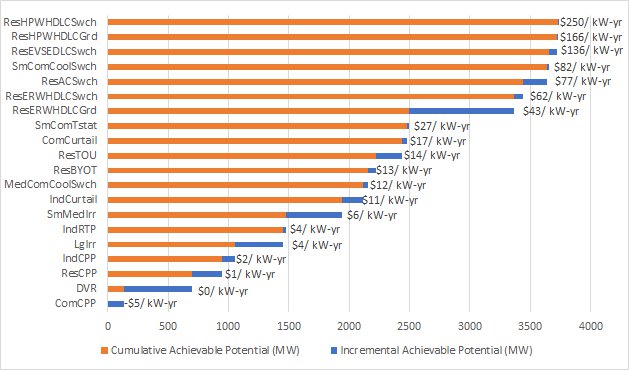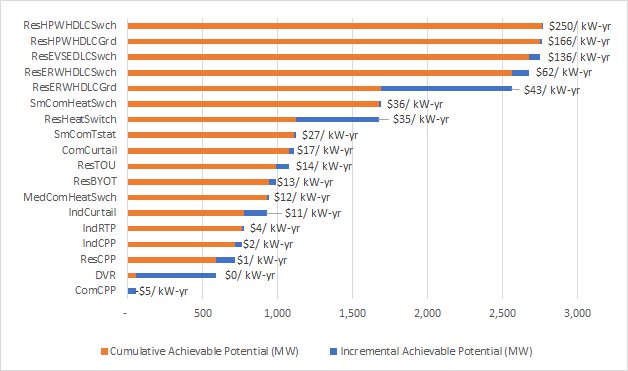The 2021 Power Plan found the total achievable technical DR potential is 3,721 megawatts for the summer period and 2,761 megawatts for the winter period by the end of the 20-year plan horizon. The achievable technical potential, also referred to as the market potential, represents the amount of impact that is likely achievable through programs, accounting for program and event participation rates. This represents approximately 12 percent and 9 percent of summer and winter peak loads, respectively.[1] This does not include additions or reductions in potential due to adoption of energy efficiency measures (e.g. increased adoption of smart thermostats through energy efficiency will increase the potential of a bring-your-own-thermostat DR product and reduce it for the heating or cooling switch product). This interaction is captured in the resource strategy analysis, and more information can be found here.
The supply curves for the summer and winter DR potential are provided in figures below. The chart represents the net levelized cost (in 2016 dollars) of each product, increasing from the bottom up. The incremental potential for a given product is given in blue, while the cumulative potential of all less expensive products is given in orange. The table below provides the full name of the products that are abbreviated in the charts.
Demand Response Achievable Technical Potential in 2041 with Net Levelized Cost - Summer

Demand Response Achievable Technical Potential in 2041 with Net Levelized Cost - Winter

List of DR Products – Abbreviated and Full Name
| Abbreviation | Residential Product | Abbreviation | Non-residential Product |
| ResCPP | Residential Critical Peak Pricing | ComCPP | Commercial Critical Peak Pricing |
| ResTOU | Residential Time of Use | IndCPP | Industrial Critical Peak Pricing |
| ResEVSEDLCSwch | Residential Electric Vehicle Supply Equipment Control | IndRTP | Industrial Real Time Pricing |
| ResERWHDLCGrd ResERWHDLCSwch | Residential Electric Resistance Water Heater Control Grid and Switch | LgIrr SmMedIrr | Irrigation Control Large and Small/Medium Farms |
| ResHPWHDLCGrd ResHPWHDLCSwch | Residential Heat Pump Water Heater Control Grid and Switch | SmComTstat | Small Commercial Bring-Your-Own-Thermostat |
| ResACSwch ResHeatSwch | Residential AC and Heat Control Switch | ComCurtail | Commercial Curtailable Load |
| ResBYOT | Residential Bring-Your-Own-Thermostat | IndCurtail | Industrial Curtailable Load |
| SmComCoolSwch SmComHeatSwch | Commercial Small Building Control Switch Cool and Heat | ||
| DVR* | Demand Voltage Regulation | MedComCoolSwch MedComHeatSwch | Commercial Medium Building Control Switch Cool and Heat |
* DVR is a cross-sector product, not solely residential
Sector specific potential is below for residential, commercial, industrial, agricultural and the utility distribution system.
Residential Sector
Products considered in the residential sector provided in the table below broken out by season and type (controllable in black text and price-responsive in italicized text). The assumptions for the residential controllable products is available here and the price- responsive products can be found here.
Residential Demand Response Products by Season
| Summer Only | Winter Only | Dual Season |
| AC Switch | Heating Switch | Bring-Your-Own-Thermostat |
| Water heater (heat pump and electric resistance) – switch | ||
| Water heater (heat pump and electric resistance) - grid-connected | ||
| Electric Vehicle Supply Equipment control | ||
| Time-of-Use | ||
| Critical Peak Pricing |
The total potential by net levelized cost for the residential sector is provided in the tables below.
Residential Demand Response 2041 Potential - Summer
| Product | Achievable Potential (MW) | Net Levelized Cost (2016 $/kW-yr) |
| Critical Peak Pricing | 251 | $1 |
| Bring-your-own-thermostat | 63 | $13 |
| Time-of-use | 214 | $14 |
| Electric resistance water heater control – grid enabled | 867 | $43 |
| Electric resistance water heater control - switch | 76 | $62 |
| AC Switch | 183 | $77 |
| Electric vehicle supply equipment control | 72 | $136 |
| Heat pump water heater control – grid enabled | 6 | $166 |
| Heat pump water heater control – switch | 1 | $250 |
Residential Demand Response 2041 Potential - Winter
| Product | Achievable Potential (MW) | Net Levelized Cost (2016 $/kW-yr) |
| Critical Peak Pricing | 125 | $1 |
| Bring-your-own-thermostat | 44 | $13 |
| Time-of-use | 90 | $14 |
| Heat Switch | 549 | $35 |
| Electric resistance water heater control – grid enabled | 867 | $43 |
| Electric resistance water heater control - switch | 115 | $62 |
| Electric vehicle supply equipment control | 72 | $136 |
| Heat pump water heater control – grid enabled | 13 | $166 |
| Heat pump water heater control – switch | 1 | $250 |
Commercial Sector
Products considered in the commercial sector are provided in the table below broken out by season and type (controllable in black text and price-responsive in italicized text). The assumptions for the commercial controllable products can be found here, while the assumptions for the price responsive products can be found here.
Commercial Demand Response Products by Season
| Summer Only | Winter Only | Dual Season |
| AC Switch (Small & Med buildings) | Heating Switch (Small & Med buildings) | BYOT (small buildings) |
| Demand Curtailment (med & large buildings) | ||
| Critical Peak Pricing |
The total potential by net levelized cost for the commercial sector is provided in the tables below.
Commercial Demand Response 2041 Potential - Summer
Commercial Demand Response 2041 Potential - Winter
| Product | Achievable Potential (MW) | Net Levelized Cost (2016 $/kW-yr) |
| Critical Peak Pricing | 55 | -$5 |
| Medium Building Heat Switch | 16 | $12 |
| Demand Curtailment | 33 | $17 |
| Bring-your-own-thermostat | 14 | $27 |
| Small Building Heat Switch | 17 | $36 |
Industrial Sector
Products considered in the industrial sector are provided in the table below differentiated by type (controllable in black text and price-responsive in italicized text). Note, all DR products for the industrial sector are dual season. The assumptions for the industrial controllable product can be found here, while the assumptions for the price responsive products can be found here.
Industrial Demand Response Products by Season
| Dual Season |
| Demand Curtailment |
| Critical Peak Pricing |
| Real Time Pricing |
The total potential by net levelized cost for the industrial sector is provided in the tables below, broken out by season.
Industrial Demand Response 2041 Potential - Summer
| Product | Achievable Potential (MW) | Net Levelized Cost (2016 $/kW-yr) |
| Critical Peak Pricing | 109 | $2 |
| Real Time Pricing | 24 | $4 |
| Demand Curtailment | 174 | $11 |
Industrial Demand Response 2041 Potential - Winter
| Product | Achievable Potential (MW) | Net Levelized Cost (2016 $/kW-yr) |
| Critical Peak Pricing | 49 | $2 |
| Real Time Pricing | 11 | $4 |
| Demand Curtailment | 151 | $11 |
Agricultural Sector
For the agricultural sector, the DR product considered includes direct load control of irrigation systems. This is split for large (greater than 2000 acres) versus small/medium farms (less than 2000 acres). From the 2018 U.S. Department of Agriculture Irrigation and Water Management Survey, about 35 percent of irrigated acres in the region fall into the “large” category. In addition, the analysis limited eligibility to customers that have at least 100 horsepower of pumping load. About 80 percent of large farms are assumed to have pumping load greater than 100 horsepower and 50 percent of small/medium farms have greater than 100 horsepower pumping loads. This translates to program eligibility of 28 percent for large farms and 33 percent for small/medium farms. Additional details on the assumptions can be found here.
The total 20-year achievable technical potential by net levelized cost for the agricultural sector is in the table below. Note, the potential is solely available in the summer and is all utility controllable.
Agricultural Demand Response 2041 Potential - Summer
| Product | Achievable Potential (MW) | Net Levelized Cost (2016 $/kW-yr) |
| Small/Medium Farms | 464 | $5.75 |
| Large Farms | 394 | $4 |
Utility Distribution System
Many utilities can reduce to voltage on their primary distribution circuits, but still be within the acceptable range defined by the American National Standards Institute. This voltage reduction has minimal impact on the end-use customer and results in lower losses, thus saving energy. This could be done on a permanent basis (Conservation Voltage Regulation [CVR]) or during short-duration events (Demand Voltage Regulation [DVR]).[2] DVR is included in the DR supply curves. Product assumptions can be found here.
The total potential for DVR is 561 MW in the summer and 538 MW in the winter, both at a net levelized cost of $0.10 per megawatt-year. Note the seasonal differences reflect differences in peak summer versus winter loads.
[1] Based on CanESM2 climate change, base economic scenario
[2] DVR could be used to either decrease or increase loads, depending on system needs. For the 2021 Plan, it was only modeled as a load reduction product.



